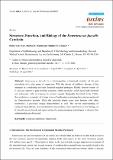Structure, Function, and Biology of the Enterococcus faecalis Cytolysin
Citation
Van Tyne, Daria, Melissa J. Martin, and Michael S. Gilmore. 2013. “Structure, Function, and Biology of the Enterococcus faecalis Cytolysin.” Toxins 5 (5): 895-911. doi:10.3390/toxins5050895. http://dx.doi.org/10.3390/toxins5050895.Abstract
Enterococcus faecalis is a Gram-positive commensal member of the gut microbiota of a wide range of organisms. With the advent of antibiotic therapy, it has emerged as a multidrug resistant, hospital-acquired pathogen. Highly virulent strains of E. faecalis express a pore-forming exotoxin, called cytolysin, which lyses both bacterial and eukaryotic cells in response to quorum signals. Originally described in the 1930s, the cytolysin is a member of a large class of lanthionine-containing bacteriocins produced by Gram-positive bacteria. While the cytolysin shares some core features with other lantibiotics, it possesses unique characteristics as well. The current understanding of cytolysin biosynthesis, structure/function relationships, and contribution to the biology of E. faecalis are reviewed, and opportunities for using emerging technologies to advance this understanding are discussed.Other Sources
http://www.ncbi.nlm.nih.gov/pmc/articles/PMC3709268/pdf/Terms of Use
This article is made available under the terms and conditions applicable to Other Posted Material, as set forth at http://nrs.harvard.edu/urn-3:HUL.InstRepos:dash.current.terms-of-use#LAACitable link to this page
http://nrs.harvard.edu/urn-3:HUL.InstRepos:11717548
Collections
- FAS Scholarly Articles [18258]
- HMS Scholarly Articles [17920]
- SPH Scholarly Articles [6362]
Contact administrator regarding this item (to report mistakes or request changes)



